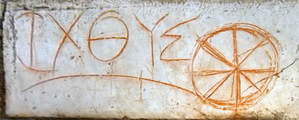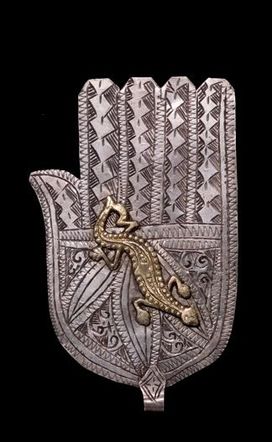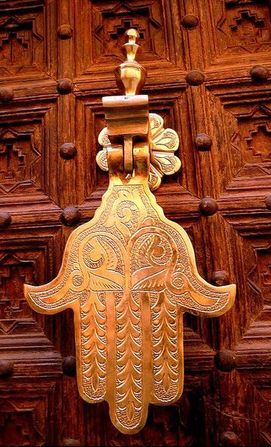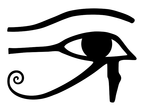|
INTERPRETATIONS OF THE FISH Universally the fish symbol has been found to represent fertility, success, good luck, harmony and emotions. When threatened, often fish will swarm together as in the photo of this sardine swarm, providing each other protection. The fish are naturally connected to the element of water which is the element often connected with healing, emotion and meditation. Fish are also considered to be connected with a sense of purposeful movement due to the rough currents that they encounter in their environment and that they overcome. This is a metaphor to life where very often rough currents and challenges can prevent or hinder people in reaching their goals. The symbol of the fish therefore reminds us of overcoming obstacles and stretching our own limits. Another interpretation for the fish symbol is the connection with fertility. Due to the fact that fish tend to lay thousands of eggs at a time, the fish represents not only fertility, but also success, thought processes, intelligence and inventiveness! As with other symbols such as the Hamsa hand itself and the eye symbol, the symbolism of the fish has different variations from culture to culture, and in some cases the species of the fish itself hold unique interpretations. THE FISH IN JUDAISM The first time in the Torah that God speaks to any living creature, the speech is directed at fish. In Genesis 1:22
In Judaism the fish are used in ceremonies and blessings are said for the fish, human beings and the Sabbath - as such the fish are considered sources of blessings. The fish symbol is also connected to the Sabbath - the 7th day- as the numerical value of the word fish dag equals the number seven. As such, on the Sabbath it is traditional to eat fish. On Rosh HaShana it is also customary to place or eat the head of the fish, symbolizing the wish to be at the "head" of the community as well as in righteousness. SYMBOL OF FERTILITY Their symbolism with fertility and abundance can be seen in an example when Jacob blessed the two sons of Joseph, Jacob said: "Let them multiply in the midst of the earth" (Genesis 48:16) In Hebrew, the word for "multiply" ve-yidgu derives from the word fish dagim. PROTECTION FROM THE EVIL EYE In the sea the fish are covered by water and thus many rabbis note that the fish are more protected from the Evil eye - a glare which is cast with intentions to cause harm. The Talmud tells us the “Evil Eye” has no effect on fish and therefore the symbols is popular among jewish people, and can be seen in many amulets against the “Evil Eye.” The fish symbol has also appeared at many entrances of private homes such as of the Jews in Djerba, North Africa and can still be seen there to some degree today.
(I) Iesous (ch) Christos (th) Theou (y) Yios (s) Soter, i.e. Jesus Christ, Son of God, Savior. The Christians used the symbol of the fish as a secret symbol to express their conviction, as well as a way to mark meeting places or tombs. Christians were also called Pisciculi. The root of the Latin word is "fish", and the Apostles were also often referred to as "fishers of men". The fish symbol also plays a role in the gospels, some examples include:
THE LETTER NUN (N) In Arabic the letter 'N' (nun) is the word for fish and in Islam, according to the Quran the fish symbolizes eternal life. In Arabic, the prophet Jonah is called Dhun-Nūn. In Hebrew, in Aramaic and Phoenician the letter Nun is also related to a fish or great whale. Although the word "whale" is often used in English versions of the Jonah story, the Hebrew text actually uses the phrase dag gadol, which means "giant fish". In my upcoming articles about the Hebrew letters relating to my HAMSA 22 - HEBREW LETTERS I will further write about each Hebrew letter and its meanings. However, at this point it is interesting to regard that in the Phonician, Hebrew, Greek, Latin and English alphabets, the letters M and N carry a thought-worthy significance. The letter M is Mu (μ) in Greek and Mem (מ) in Hebrew and Phonician tongues. This word in and by itself means "the sea" and in Hebrew symbolizes water mayim. Their ancient as well as modern shapes indicate that they derive from the Egyptian hieroglyphic forms and of a wave or water mark. The letter N is Nu in Greek and Nun in Hebrew and Phonician and as previously mentioned means "fish." In the alphabets these letters follow one another in the sequence, and thus it is as if one reads Nun, Mem - "The sea; the fish." In the practice of Feng Shui - a way of decorating and by using energy forces to harmonize individuals with their surrounding environment - many Chinese have an aquarium at a well thought placement in the house or office as it is believed that this will enhance wealth, career and luck. The fish also here represent fertility! As fish often swim in pairs, in China they also symbolize fidelity, unity and is therefore often given as a wedding present. THE FISH IN BUDDHISM In Buddhism the fish symbol is one of the 8 Auspicious Symbols. The fish symbolizes the art of living in a state of fearlessness, without danger of drowning in sufferings, and freely migrating from place to place. There are many more interpretations and stories about the fish symbolism and this article is therefore not a comprehensive list. The fish remains a powerful symbol across cultures to this day, and to many people the fish symbol still plays a significant part of their daily lives. Reference: The Encyclopedia of Jewish Symbols, Ellen Frankel, Betsy Platkin Teutsch
4 Comments
In English the hamsa hand is often referred to as ‘the hand of God’ and sometimes ‘the healing hand’. The hamsa hand is a thought to be a popular symbol and can be found throughout the Middle East and northern Africa, in particular among the Islamic and Jewish faiths. Among Levantine Christians it is called 'the hand of Mary', for the Virgin Mary. As a Muslim symbol the hamsa hand is known as ‘the hand of Fatima’ referring to Fatima the daughter of Muhammad. In Islamic culture it is thought to be a symbolic representation of the five pillars of Islam. As a Jewish symbol the hamsa is related to as ‘the hand of Miriam’. The hamsa hand is however a universal protective symbol thought to provide its owner happiness, luck, good health, and good fortune. The hamsa also offers guards from harm caused by the evil eye. Below are two examples of my unique Hamsa Hand artwork that i create in ink. Check out my Hamsa art on my website & find beautiful art prints in my shop! ORIGINS OF THE HAMSA HAND As with most ancient symbols it can very be hard to trace the exact date and origins of the hamsa hand. Different scholars believe that the the symbol is of Pagan origin, later adopted by various religions. Possibly the hamsa hand symbol originates from Mesopotamia (modern day Iraq and parts of modern-day Iran, Syria and Turkey), ancient Egypt or Carthage (modern day Tunisia), where a Punic and Phoenician goddess Tanit was worshipped. Some turn to Egypt to trace the Hamsa hand source, referring to the Hand of the All-Goddess, Isis whilst in Greece, the symbolism was seen in connection to Aphrodite. Yet another historic pre-curser or link to the hamsa hand is an amulet which was known to ancient Egyptians as the 'Two Fingers'. The 'Two Fingers' amulet was worn as a protective talisman by both the living and the deceased. It represents the medius and index fingers.
THE SHAPE OF THE HAMSA HAND SYMBOL The Hamsa can appear in different shapes, sometimes the palm is pointing upwards and at other time downwards, which invite many different interpretations. Some hamsas can be found with two symmetrical thumbs as well as asymmetrical. Either form may be displayed with the fingers pointing up or down. The centre of the palm is very often decorated with other symbols, especially the eye, yet various cultures may decorate the hand with symbols and images that are relevant to them. THE HAMSA HAND IN THE JEWISH WORLD People have mostly associated the hamsa hand with Islam. Its way into Jewish culture, and its popularity in Jewish Sephardic and Mizrahi communities, can also be traced through its use in Islam. Over time, the hamsa hand has undergone a kind of ‘Judaization’ which has led to the acceptance and legitimization of the hamsa hand symbol in the entire Jewish world. It is also considered a very popular and treasured object in the modern State of Israel where it is increasingly embraced by the secular Israeli population as well. According to some scholars this process could happen because Jews in both Christian Europe and Islamic countries take on the folkloric elements of their host cultures. Among Jews living in other Islamic countries, including Iran, Afghanistan, Bukhara, Iraq, and Kurdistan the hamsa hand was very popular and often used at home as well as in the synagogues (Sabar, 2002).
For Jewish believers, the shape of the open hand also drew connections to the hands of priests (kohanim) who impart their blessing worshippers attending the ceremonies. Among the Jews of Europe they continued to use the stretched out hand as a characteristic sign of the priesthood. The hand in some circumstances thus played a dual role; for example, on a Torah ark curtain from Istanbul a pair of blessing hands appear representing the priestly blessings.
The tablet was hung on the wall as an amulet for protection, and on it above the fingers is written ‘safe-guard against the evil eye´, which points to the role of its more magical properties. The tablet is most likely based on the popular Islamic type depicted below, although the Jewish version is embedded with traditional Jewish ideas. The power and protective elements of the number five has been linked in various ways, for example that it was on the 5th day of Creation that the biblical blessings for the fish were spoken. The fish are in themselves symbols of success and fertility (Sabar, 2002) THE HAMSA HAND'S REVIVAL The Hamsa hand is today a fashionable and popular symbol that is increasingly embraced by Western cultures as well. It can be seen in fashion as well on objects and unique artwork which find its way into people's homes. There can be many reasons for this openness and usage for the ancient symbol in the Western cultures, beyond the aesthetic and fashionable aspect. Perhaps with the rise of social media where we expose our lives to a higher degree and reveal our successes and good fortune, there is also a higher need to seek out protective defense mechanisms, such as from ancient symbols as the Hamsa hand.
READ MORE ABOUT SYMBOLS USED IN THE HAMSA HAND Explore the different symbols i use in my Hamsa Hand artwork such as the dove, the eye, the eagle, the double-headed eagle, the tree of life, the fish and the pomegranate fruit ! You can also shop unique HAMSA HAND ART PRINTS in my Etsy store online and explore the Hamsa Hand art on my website ! FOLLOW ME ON FACEBOOK / INSTAGRAM Sabar, S. (2002). From Sacred Symbol to Key Ring: The Khamsa in Jewish and Israeli Societies
THE CURSE OF THE EVIL EYE The evil eye is a curse or a legend alleged to be cast by a malicious glare given to inflict harm, misery, or some form of bad luck on the person that the glare is cast upon. Giving someone “the evil eye” is a look where one intends for something bad to happen to the other person, either out of jealousy or pure malice. In many cultures, it is believed that the look is powerful enough to bring about actual misfortune for the unlucky person that receives the look, and many different cultures therefore take protective measures against it, such as through amulets and talismans. Wearing an evil eye as an amulet or hanging the talismans in the home is thought to bring protection against such evil forces. The curse of the evil eye basically stems from the belief that anyone who accomplishes great success or recognition will also attract the envy of those around them. That jealousy in turn reveals itself as a curse to end their good fortune. The Egyptians dreaded the evil eye which was ever present, and the Eye of Horus is an ancient Egyptian symbol of protection, royal power and good health. The symbol of the Evil eye has been mentioned in ancient literature stemming from classical antiquity, such as in Hesiod, Plato, Pliny the Elder, Theocritus and Plutarch. An example from Plato’s Phaedo 95b: “My friend,” said Socrates, “do not be boastful, lest some evil eye put to rout the argument that is to come. " He theorized that the human eye had the power of discharging invisible rays of energy that were sometimes strong enough to kill small children or animals. According to Plutarch, certain people have a stronger ability to bestow the curse, and those most proficient in delivering it are blue-eyed, perhaps due to this less common genetic feature in the Mediterranean area. As for the colour blue, according to Dr Nese Yildiran, an art history professor at Istanbul’s Bahçeşehir University, it definitely first comes from Egyptian glazed mud, which contains a high percentage of oxides. The copper and cobalt give the blue colour when baked. According to Yildiran, early Turkic tribes held a strong fascination with this shade of blue because of its connections with their sky deity, Tengri, and likely co-opted the use of cobalt and copper as a result. More and more people are seen wearing the eye symbol, including wearing the entire Hamsa Hand as amulets where the eye is also a common feature. The Hamsa hand is a symbol that is believed to symbolize protection and strength. Others prefer larger pieces of the Hamsa symbol and it can be seen in artworks, such as in my own Hamsa art. Many people hang pictures of the Hamsa Hand on the wall in their home for protection and good blessings. It is also often given as a gift when moving in to a new home or office or any other occasion. The eye symbol is truly a remnant from the very dawn of civilization, going back to some of humanity’s most persistent and profound beliefs. There are therefore many more symbolic interpretations of the eye not covered in this article. Should you wish to explore the symbol further, there is a lot of online information as well as a book specifically on the subject called: The Evil Eye: The Classic Account of an Ancient Superstition by Frederick Thomas Elworthy |
MAY-BELL
|































 RSS Feed
RSS Feed
